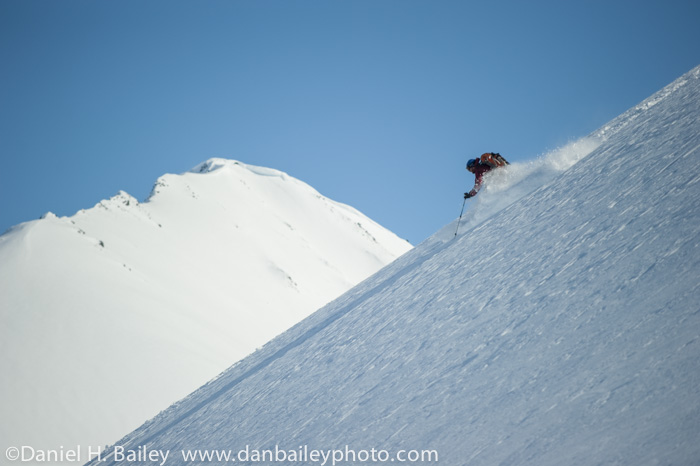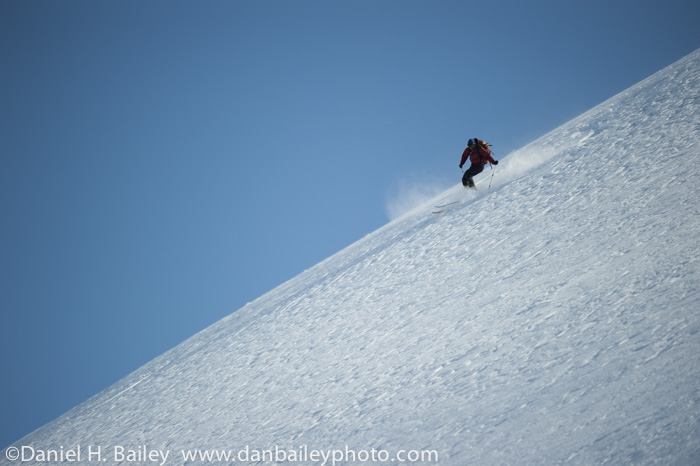Adventure and outdoor photography is largely about nailing an awesome moment in a stunning backcountry setting. However, when you’re out there in the middle of the action and everything is moving quickly, it can be hard to stay on top of all the technical and creative elements at hand and make it all come together. Today I want to give you some quick tips and show you what I feel are the four steps towards getting that great shot.
For this Alaska backcountry skiing image, I used my Nikon DSLR and the Nikon AF-S 70-200mm f/4G ED VR Telephoto Zoom Lens. I call this the adventure photographer’s dream lens, because it’s got pro quality coated glass and it’s half the weight of the 3 lb. Nikon 70-200mm f/2.8G ED VRII. Plus it’s a thousand dollars less expensive. (Read my full comparison of these two lenses here.)
1. Location
Location, location, location. The backbone of your image. It’s called adventure photography for a reason. With this kind of image making, nothing matters more than where you are. Putting yourself into the best vantage points in the most amazing parts of the world is the number one ingredient to a jaw-dropping photograph. There is no substitute.
Usually, this part entails things like road trips, plane tickets, plans made at the bar, being an great shape, good friends/partners and competent ability in whatever sport or activity that you’re photographing. Or just getting your butt off the chair and going outside.
2. Light
The main element in all good photographs. Without good light, you’ll have a hum-drum picture that will carry very little visual impact. Imagine this picture being made on a dark, overcast day. Just wouldn’t have the same punch. Even though it’s wasn’t shot at magic hour, the strong, low winter sunlight and rich blue sky make for a lively contrast against the white show and the nice, red jacket of the skier.
Don’t underestimate the power of bright clothing in your shot. In fact, it’s always good to have some extra jackets on hand to lend friends who insist on on wearing drab colored clothing. There’s always at least one, isn’t there?
Ready for a joke?
- Q: How can you spot the photographer in the outdoors?
- A: He’s the only one wearing all black.
3. Convergence
The strongest photos show the subject in context with their environment. If you don’t have some sort of a background, or one or two secondary subject elements in the shot to add interest, you’re image won’t have any sense of place. No relationships. No story. You need to have that stuff in order to give the shot depth.
In a setting such as this, it’s pretty easy- I just look for a compelling background element in the landscape. In this case, I picked out a distant mountain that I wanted to frame behind my skier as he went by. This works because not only does it give some dimension to the shot, it’s far enough away that it will be slightly out of focus. Using bokeh on the background is an extremely effective way to isolate your subject and pull it out with sharp focus against a sea of soft blur. That’s why fast telephoto lenses are such essential tools for adventure photographers.
4. Moment
Once you’ve got all the other stuff in order, it simply becomes a matter of timing. Nailing the moment. Hitting the peak of the action. See how this shot below has the skier in a great body position and both he and the background are in an optimum part of the frame? You may only have one chance to get it right, and if you do, your shot will be so much better.
You can either put the camera on fast continuous mode, or shoot quickly, using one frame at a time. I do both, although if it’s a matter of hitting the subject in a very precise location, you’re better off putting it on single and relying on your technique and rock solid timing of your shutter finger rather than just spraying and praying.
If you don’t have a fast enough motor drive, you could actually miss hitting a frame exactly where you want. Sometimes it’s better to do multiple passes or shoot multiple subjects with good timing of your eye and fire off one or two shots at EXACTLY the right moment. After all, who’s smarter, you or your camera?




